学校作为中黄融课的实践学校,通过中黄融课课程体系的三类课型,
创造性地实施高质量的国家课程,同时全面培养孩子面向未来的能力和素养。
The school, as a practical school for ZWIE integrated curriculum, creatively implements high-quality national courses through the three types of courses in the integrated curriculum system. At the same time, it comprehensively cultivates children's abilities and literacy prepared for future career.
跨学科课程
Interdisciplinary Learning
打破学科界限 探究知识本质
Break the boundaries of disciplines and explore the nature of knowledge
学科课程
Subject-specific Learning
聚焦学科本质 深化学科素养
Focus on disciplinary literacy and deepen disciplinary understanding
拓展活动课
Extra Curricular Activities (ECA)
发展个性特长 开阔全球视野
Unity of Knowledge and Action, development of personality
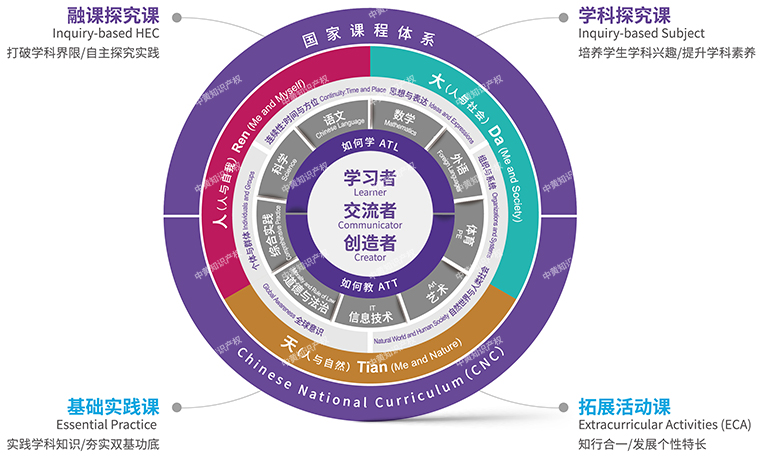
- 跨学科课程
Interdisciplinary Learning - 学科课程
Subject-specific Learning - 拓展活动课
Extra Curricular Activities (ECA)
Break the boundaries of disciplines and explore the nature of knowledge
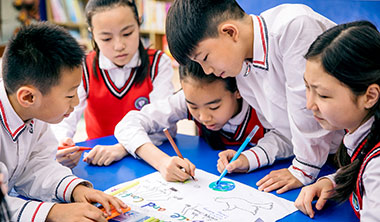
跨学科课程通过先进的大单元探究,将国家课程中的学科内容进行有机整合,培养学生“举一反三”的知识迁移能力与高阶思维能力。在跨学科课程中,学生以世界为课堂,以生活为素材,在真实的情境中释放好奇心,通过设疑、探疑、解疑、思疑、释疑的探究循环形成自己对于事物独特的理解,并将其运用到现实生活中。
跨学科课程围绕六个极富人文底蕴与全球视角的大概念主题展开,它们分别是:个体与群体、连续性——时间与方位、思想与表达、组织与系统、自然世界与人类社会以及全球意识。不同年龄段的学生都可以在这六大主题下汲取适合所处认知发展阶段的知识,强化他们的综合素养,探究中内容的深度与难度会随着学生的成长呈螺旋式上升。
在学习成果展示及评估方面,跨学科课程打破了传统课堂中“唯分数”的单轨评估方式,提出了过程与结果同样重要的多元评估体系。在单元结题展中,学生将全面展示自己在本单元中的收获,与同伴、家长和学校社区一同反思、共同进步。
The interdisciplinary learning organically integrates the subject content of the national curriculum through advanced large unit inquiry and cultivates students' knowledge transfer ability and high-level thinking ability. During the interdisciplinary learning, students use the world as the classroom and life as the material to release their curiosity in a real situation and form their own unique understanding over different topics. Through the inquiry cycle of questioning, probing, resolving, thinking, and sorting out their doubts. And finally apply them to real life.
The interdisciplinary learning is carried out around six broad conceptual themes with rich humanistic background and global perspective. Being them: individually and group, continuity -time and space, thought and expression, organization and system, natural world and human society, and global consciousness. Students of different ages can learn knowledge suitable for their cognitive development stage under six themes and strengthen their comprehensive literacy. The depth and difficulty of the content in the inquiry will spiral upward with the growth of students.
In terms of the display and evaluation of learning results, the interdisciplinary learning breaks the single-track evaluation method of "score-only" in the traditional classroom. It proposes a multi-evaluation system in which the process is as important as the result. At the end of each unit, there will be presentations. Students will fully demonstrate their gains in this unit, reflect and make progress together with their peers, parents, and the school community.
Focus on disciplinary literacy and deepen disciplinary understanding
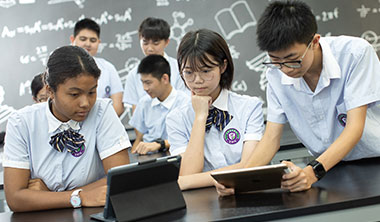
学科课程与传统学科中的“照本宣科”有本质上的差别。我们的学科课程以学科概念为支点,直指学科本质,深化孩子的学科素养。
英语课上,学校开展英语绘本阅读,学生通过故事学习生词和句型;开展小组角色扮演活动,模拟故事发生的情景,激发学生学习的兴趣、更深一步帮助学生理解阅读的内容。
语文课中,以动手拼贴、思维导图、想象创编、话剧表演等多种形式开展教学,让孩子成为课堂的主人。
The subject-specific learning is essentially different from the "traditional teaching" in traditional subjects. Our subject-specific learning takes the subject concept as the fulcrum, points directly to the nature of the subject, and deepens the children's subject literacy.
In English class, the school carries out English picture book reading, students learn new words and sentence patterns through stories; group role-playing activities are carried out to simulate the scenes of stories, stimulate students' interest in learning, and further help students understand the content of reading.
In the Chinese class, teaching is carried out in various forms such as hands-on collage, mind mapping, imagination creation, and drama performance, so that children can become the masters of the classroom.
Unity of Knowledge and Action, development of personality

在中西融合的课堂教学之外,学校还开设了涵盖科技、乐器、美食、美术、运动、文化等逾50项的拓展活动,帮助孩子发现兴趣、挖掘潜能,助力他们成为独一无二的自己。
以中华传统文化为例,学校创造性地将茶道、非遗、礼仪、24节气等融入课堂内外,强化学生的国家认同、民族认同,树立文化自信,通过情境创设培养学生的跨文化理解能力及交流能力。
秉承因材施教、呵护每个孩子的个性成长的初心,学校会根据孩子们不同的需求匹配不同的老师进行差异化教学。除此之外,学校还组织让孩子们的天赋“被看见”的各类主题活动,鼓励孩子们的多元发展。
In addition to the Chinese and Western classroom teaching, the school also opened more than 50 expansion activities covering technology, musical instruments, food, art, sports, culture, etc. to help children discover their interests, tap their potential, and help them become unique selves.
Taking traditional Chinese culture as an example, the school creatively integrates tea ceremony, intangible cultural heritage, etiquette, 24 solar terms, etc. into and out of the classroom to strengthen students' national and ethnic identity, establish cultural self-confidence, and cultivate students' cross-cultural understanding and communication through context creation ability.
Adhering to the original intention of teaching students in accordance with their aptitude and caring for the growth of each child's personality, the school will match different teachers for differentiated teaching according to the different needs of the children. In addition, the school also organizes various themed activities that let children’s talents "be seen" to encourage children's diversified development.
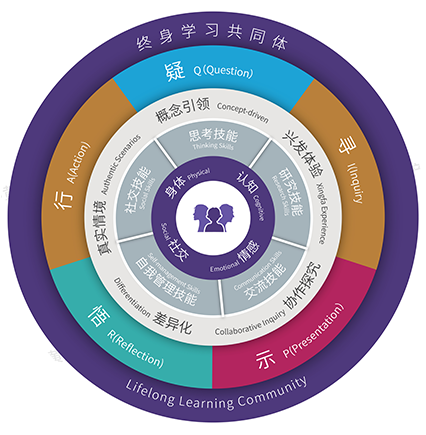
唤醒孩子的内驱力,从“要我学”到“我要学”的终身学习力
秉持“学起于思,思源于疑”的教学理念而独创的快普乐课堂教学模式,明确了学生作为学习者的核心地位,从以“教”为主变为以“学”为主。
将探究学习总结为“疑”、“寻”、“释”、“悟”、“行”五大步骤,鼓励学生由疑发端,通过设疑、探疑、解疑、思疑、释疑五个阶段完成探究循环,积极引导学生主动思考、积极提问、自主探究,让学生成为生活和学习的主人。
Arouse children’s internal motivation from "I need to learn" to "I want to learn”, which is a life-long learning ability
Adhering to the teaching philosophy of "learning starts from thinking, thinking comes from doubt" and the original QIPRA (
Adhering to the teaching philosophy of "learning starts from thinking, thinking comes from doubt" and the original QIPRA (inquiry-based learning and teaching) classroom teaching mode. It clarifies the core status of students as learners, from "teaching" to "learning".
It summarizes inquiry learning into five steps: "doubt", "seeking", "explain", "enlightenment" and "action". This can encourage students to start from doubt and complete them through five stages: doubt setting, inquiry, doubt resolution, think doubt, and dispel doubt. The cycle of inquiry actively guides students to think actively, ask questions, and explore independently so that students become masters of life and learning.

结合本土英语教材的基础上,对标英语评测的国际标准,为学生提供连续性的英语学习评估,包括普通英语和学术英语两大部分,采取中外教协同教学和分层走班的差异化教学,使学生能够按照所在年级、学段、学科英语水平规定达标,确保双语学习、双语能力能够落实到位。
Based on combining local English teaching materials and international standards of English evaluation, it provides students with continuous English learning assessment, including general English and academic English. It adopts Chinese and foreign teachers' collaborative teaching and differentiated teaching of stratified classes so that students can meet the standards of English proficiency according to their grades, sections, and subjects to ensure efficient bilingual learning.
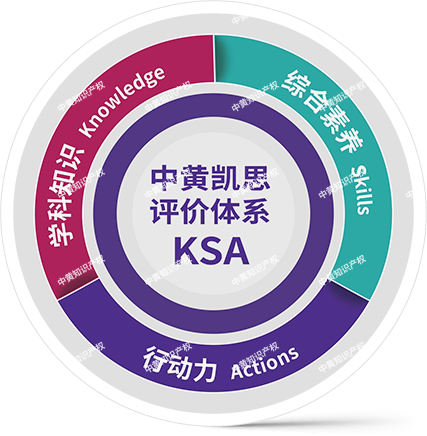
该评价体系涵盖了学科知识、综合素养、行动力三大维度,实现对于学生学科知识掌握的评估、对于学生全面发展的评估、对于学生态度、行动力及品格的评估。
从知识层面主要是对于国家课程的评估,检验学生对于学科知识的掌握与理解,是对学习目标与标准明确具体的评估,反馈与前反馈形成闭环。
从综合素养方面主要考察学生在思考技能、研究技能、沟通技能、社交技能以及自我管理技能方面的成长。
从行动上考察学生在真实世界中学以致用的能力,注重学生自身发展与外部世界的联系。
The evaluation system covers three dimensions of subject knowledge, comprehensive literacy, and action ability. Besides, its also realizes the assessment of students' subject knowledge mastery, the assessment of students' overall development, and the assessment of students' attitudes, actions and character.
From the knowledge level, it is mainly the evaluation of the national curriculum which tests students' mastery and understanding of subject knowledge. It is a clear and specific evaluation of learning goals and standards. Feedback and pre-feedback form a closed loop.
From the aspect of comprehensive literacy, it mainly examines the growth of students in thinking skills, research skills, communication skills, social skills, and self-management skills.
It examines the students' ability to apply what they learn in the real world from the action, and pays attention to the connection between the students' own development and the external world.